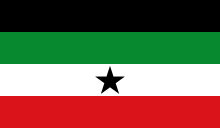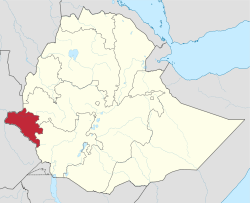Gambela Region
Gambela or Gambella, (Amharic: ጋምቤላ) also officially known as Gambela Peoples' Region, is one of the ten regional states (kililoch) of Ethiopia. Previously known as "Region 12", its capital is Gambela. The Region is situated between the Baro and Akobo Rivers, with its western part including the Baro salient.
Gambela Peoples' Region ጋምቤላ ሕዝቦች ክልል | |
|---|---|
 Flag  Seal | |
 Map of Ethiopia showing Gambela Region | |
| Country | Ethiopia |
| Capital | Gambela |
| Government | |
| • Governor | Omot Ojulu Obub (GPDM) |
| Area | |
| • Total | 29,782.82 km2 (11,499.21 sq mi) |
| [1] | |
| Population (2017) | |
| • Total | 435,999[2] |
| ISO 3166 code | ET-GA |
| HDI (2017) | 0.539[3] low · 4th |
Located in Gambela is Gambela National Park, which covers approximately 5,061 square kilometers or 17% of the Region's territory.
Demographics
Based on the 2007 Census conducted by the Central Statistical Agency of Ethiopia (CSA), the Gambela Region has total population of 307,096, consisting of 159,787 men and 147,309 women; urban inhabitants number 77,925 or 25.37% of the population. With an estimated area of 29,782.82 square kilometers, this region has an estimated density of 10 people per square kilometer. For the entire Region 66,467 households were counted, which results in an average for the Region of 4.6 persons to a household, with urban households having on average 3.8 and rural households 4.9 people. The Gambela Region is mainly inhabited by various Nilotic ethnic minority populations (Nuer 64.66%, Anuak 29. 6%, Mezhenger 5%), as well as some Omotic groups (Kafficho 6.04%, Shakacho 2.27%), Afro-Asiatic populations (Amhara 8.42%, Oromo 4.83%, Kambaata 1.44%, Tigray 1.32%), and other ethnic groups predominantly from southern Ethiopia 4.86%. Anuak language is spoken as a first language by 48.35%, 22.02% speak Anuak, 11.11% Amharic, 4.85% Afaan Oromoo, 4.65% Kafa, 2.48% Shakacho, 1.47% speak Kambaata, and 1.32% speak Tigrinya; the remaining 3.75% spoke all other primary languages reported.
Gambela is the historic home of the indigenous Anuak. In recent years there has been significant violence between the Anuak and more recently arrived Ethiopians, who are generally referred to as "Highlanders". The 1994 national census reported the regions population to be 181,862 in 35,940 households, of whom 92,902 were men and 88,960 women; 27,424 or 15.08% of the population were urban inhabitants. (This total also includes an estimate for all 19 kebeles of one woreda and 6 kebeles in two other woredas, which were not counted; these areas were estimated to have 19,465 inhabitants, of whom 9,203 were men and 10,262 women.) The six largest ethnic groups of the region were the Nuer (39.7%), the Anuak (27.45%), Amhara (7.74%), Oromo (6.49%), Mezhenger (5.76%), and Kafficho (4.18%); all other ethnic groups made up 8.68% of the population. Nuer is spoken as a first language by 39.72%, 27.47% speak Anuak, 8.44% Amharic, 6.45% Afaan Oromoo , and 5.75% speak Majang; the remaining 12.17% spoke all other primary languages reported. A plurality of the inhabitants said they were Protestant, with 44.01% of the population reporting answers in that category, while 24.13% professed Ethiopian Orthodox Christianity, 10.28% practiced traditional religions, 5.15% were Muslim, and 3.21% were Catholic.[4]
Values for reported common indicators of the standard of living for Gambela as of 2005 include the following: 44% of the inhabitants fall into the lowest wealth quintile; adult literacy for men is 57.5% and for women 22.8%; and the Regional infant mortality rate is 92 infant deaths per 1,000 live births, which is greater than the nationwide average of 77; at least half of these deaths occurred in the infants’ first month of life.[5]
Religion
70.1% of the region's population are Protestant, 16.8% Orthodox Christian, 4.9% Muslim, 3.8% practice traditional religions, 3.4% Catholic[6] The projected population for 2017 was 435,999.[2]
Refugee camps
There are a number of refugee camps located in Gambela Region housing around 268,000 refugees from South Sudan in August 2016:[7]
| Nguenyyie | Pugnido 1 | Pugnido 2 | Tierkidi | Kule | Jewi | Leitchuor | Okugo | |
|---|---|---|---|---|---|---|---|---|
| 2016 numbers | – | ~62,800 | – | ~54,750 | ~49,410 | ~42,570 | ~4,480 | – |
| 2018 numbers | ~83,660 | ~66,400 | ~17,300 | ~71,100 | ~53,340 | ~60,060 | – | ~13,630 |
From August 2016 to August 2018, the numbers increased from 268,000 to 402,000 refugees, almost equaling the native population of Gambela Region.[8]
Economy
The CSA reported that for 2004-2005 3,734 tons of coffee were produced in Gambela, based on inspection records from the Ethiopian Coffee and Tea authority. This represents 1.64% of the total production in Ethiopia. The CSA could not provide livestock estimates for Gambela.[9] In a 26 May 2000 report, the FAO observed that at the time Trypanosomiasis was a major problem in cattle for this Region.[10] There was an epidemic of this disease in the area during 1970.[11]
Gambela is believed to have major oil resources. In June 2003, the Ethiopian government signed an agreement with Petronas of Malaysia for the joint exploration and development of oil resources in Gambella region. Petronas then awarded a contract for seismic data acquisition to China’s Zhongyuan Petroleum Exploration Bureau (ZPEB) October of that year.[12]
The Water and Mines Resources Development Bureau of Gambela announced January 2007 that it was initiating a program that would drill 13 new manually operated wells, 54 new deep water wells, and develop four springs. This would provide access to drinking water for 26,000 inhabitants, increasing coverage for the state to 42 percent from the existing 27 percent, at a cost of 6 million Birr.[13] Construction of an asphalt road 102 kilometers in length and connecting Gambela City with Jikawo by way of Itang was begun in 2008 with a budget over 446 million Birr.[14]
Administrative subdivisions
While Gambela is subdivided into administrative zones and woredas as other Regions in Ethiopia are, this region has seen the most changes in these subdivisions of any region, to the point they can confuse anyone tracing their development. Originally, Gambela was subdivided into four administrative zones without proper names (1, 2, 3 and 4) and one special woreda (Godere special woreda). By 2001, when the CSA released its Sample Agricultural Enumeration, these four zones had been combined into two, and Godere had been merged into the second administrative zone.
By the 2007 census, Gambela had been redivided into three zones (named for the three largest ethnic groups), and the area around Itang town had been made a special woreda; borders of existing woredas were moved around to create several new ones within the zones. These zones are:
Anuak zone is by far the largest of the zones of Gambela Region and also includes the capital, Gambela. The terrain is mostly flat at elevations between 400 – 550 meters above sea level but with the eastern fringes of Anuak zone and in particular the easternmost zone, Mezhenger, being partly in the highlands and going up to an elevation of ~2000 meters near the eastern border.
Governors and chairmen of the ruling party
The governor of Gambela Region is usually also the chairman of the ruling party in Gambela Region, an ally of the ruling party coalition of Ethiopia, the EPRDF. The parties allied to the EPRDF changed over time so the following list also provides their names. The list starts in 1991 after the EPRDF won the Ethiopian Civil War in 1991 and with the formation of the first allied party in Gambela Region.
- Governor and chairman of the ruling party in Gambela Region 1991 – 2018:
- Agwa Alemu (GPLM) 1991 – 1992
- Okello Ouman (GPLM) 1992 – 1997
- Okello Gnigelo (GPDF) August 1997 – 2003
- Okello Akway 2003 – 2004
- Keat Tuach Bithow (acting) January 2004 – 2005
- Omod Obong (GPDM) 29 September 2005 – April 2013
- Gatluak Tut Khot (GPDM) April 2013 – October 2018
- Omud Ojulu Obub (GPDM) October 2018 – present
(This list is based on information from Worldstatesmen.org.)[15]
References
- 2011 National Statistics Archived March 30, 2013, at the Wayback Machine
- Population Projection of Ethiopia for All Regions At Wereda Level from 2014 – 2017. Federal Democratic Republic of Ethiopia Central Statistical Agency. Archived from the original on 6 June 2018. Retrieved 4 June 2018.
- "Sub-national HDI - Area Database - Global Data Lab". hdi.globaldatalab.org. Retrieved 2018-09-13.
- 1994 Population and Housing Census of Ethiopia: Results for Gambela Region, Vol. 1 Archived November 19, 2008, at the Wayback Machine, Tables 2.1, 2.7, 2.15, 2.18, 2.23 (accessed 1 September 2009)
- Macro International Inc. "2008. Ethiopia Atlas of Key Demographic and Health Indicators, 2005." (Calverton: Macro International, 2008), pp. 2, 3, 10 (accessed 28 January 2009)
- Census 2007 Tables: Gambela Region Archived November 14, 2010, at the Wayback Machine, Tables 2.1, 2.5, 3.1, 3.2, 3.4.
- "Situation South Sudan". data.unhcr.org. Retrieved 20 April 2018.
- "Total refugees from South Sudan". data.unhcr.org. Retrieved 28 October 2018.
- CSA 2005 National Statistics, Table D.2.
- "Special Report FAO/WFP Crop and Food Supply Assessment Mission to Ethiopia", section 4.5. (Accessed 21 June 2006)
- "Local History in Ethiopia" Archived 2008-02-27 at the Wayback Machine (pdf) The Nordic Africa Institute website (accessed 29 January 2008)
- "Seismic Survey Project in Ethiopia Put into Operation" Archived 2007-09-29 at the Wayback Machine (ZPEB press release)
- "Bureau launches 71 water projects in Gambella State" Archived 2007-09-27 at the Wayback Machine (Walta Information Center)
- "Construction of Gambella-Etang-Jikawo asphalt road well in progress", Ethiopian News Agency, 13 May 2009 (accessed 30 May 2009)
- According to the account provided by Human Rights Watch (HRW), there was a president of Gambela prior to Okello Ouman, who was killed by his own troops in 1991. HRW provides no further information on this individual, not even a name."Targeting the Anuak: Human Rights Violations and Crimes against Humanity in Ethiopia's Gambella Region"
External links
- FDRE States: Basic Information - Gambella
- "Violence in Gambella: An Overview" on the site of Oxfam America.
- "The Current Situation in Gambella", Press Release from the Federal Democratic Republic of Ethiopia, Ministry of Federal Affairs
- Map of Gambela Region at UN-OCHA
- Map of the Gambela Region at the Disaster Prevention and Preparedness Agency (DPPA) of Ethiopia
Further reading
- Fred Pierce, 'The Land Grabbers'
- Medhane Tadesse, "Gambella: The impact of local conflict on regional security" Institute for Security Studies website
- Human Rights Watch, "Targeting the Anuak: Human Rights Violations and Crimes Against Humanity in Ethiopia's Gambella Region"